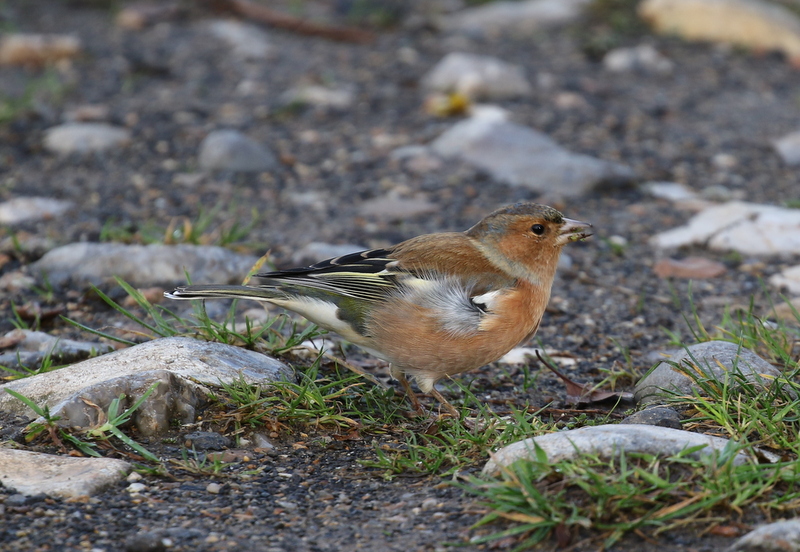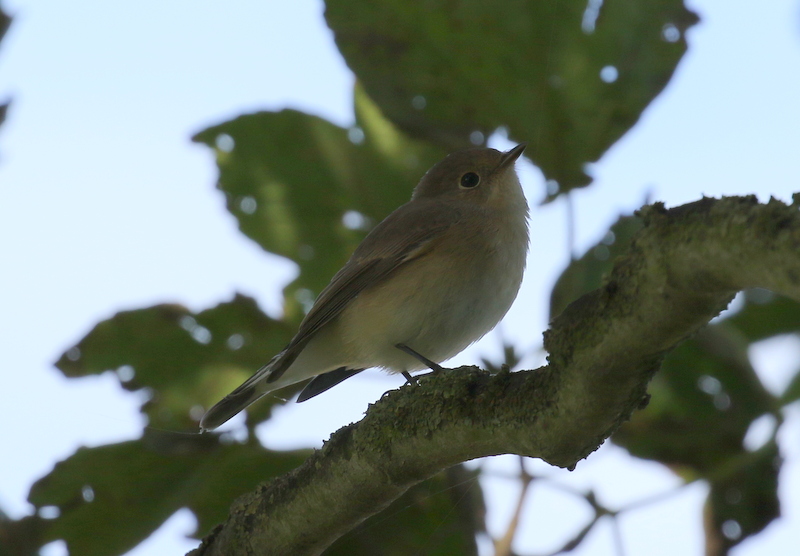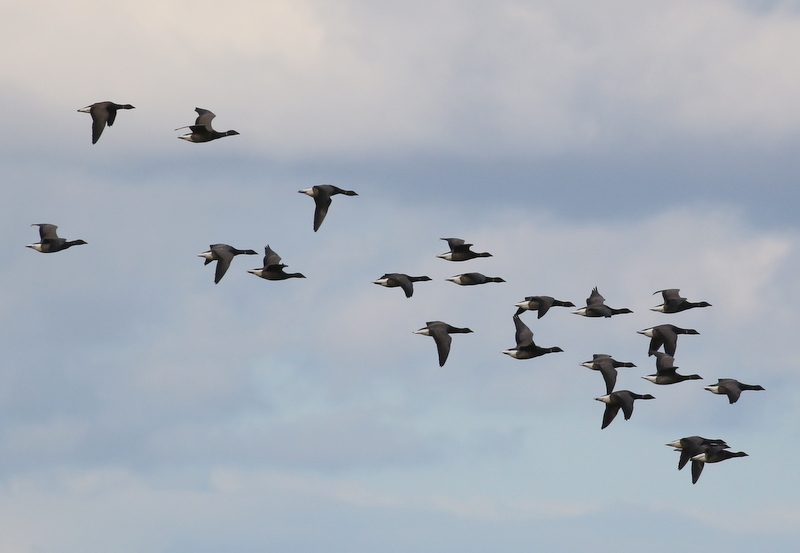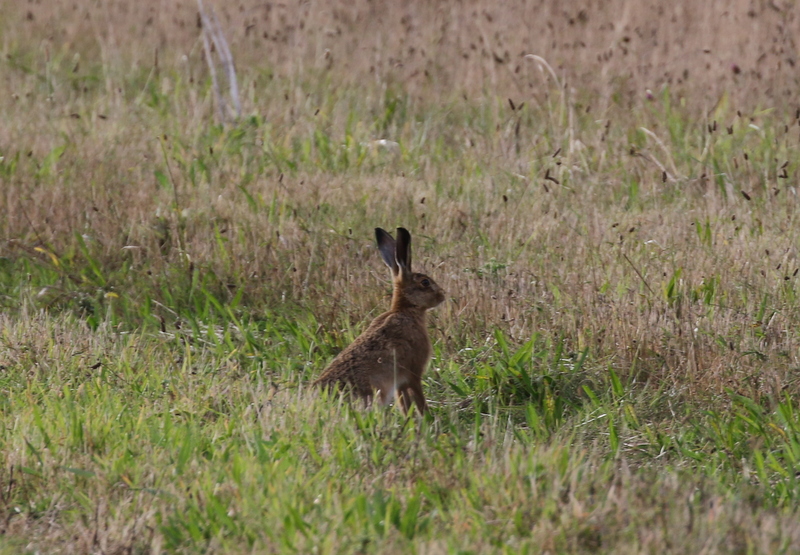Day 2 of a 3 day long weekend of Autumn Migration Tours today. Thankfully the overnight rain cleared through just before we met up this morning. The rest of the day was mostly bright with sunny intervals, and even the couple of dark clouds which went over later in the afternoon produced no more than a couple of drops of rain. It was a lovely autumn day to be out.
Our destination for the morning was Warham Greens. We parked at the start of one of the tracks and walked along towards the coast. In the first field, they were just starting to harvest potatoes. As the tractor and trailer drove in, it flushed a large flock of Golden Plover, which flew up calling mournfully, followed by a flock of Lapwing. As the harvester started to make its way through the middle of the field, it was pursued by a noisy mob of Black-headed Gulls.
The track was lined with thick hedges which are dripping with berries at this time of year. We flushed lots of birds from the bushes as we walked along, presumably mostly migrants fresh in from the continent. There were thrushes galore – Blackbirds, Redwings and a few Song Thrushes. Several harsh scolding ‘tchack’ calls alerted us to the presence of a Ring Ouzel, but it was hiding deep in the hedge. We just got a glimpse of it before it flew out the back and across the field.
The birds were hard to see perched, because they either flew ahead of us or dived deep into the hedge. But it is quite a spectacle to see so many birds, migrants which have just arrived here. Every few metres we flushed another Robin or Blackcap. We could hear lots of Goldcrests too and see them occasionally flitting around in the bushes – amazing to think that these tiny birds had probably just flown in across the North Sea. Three Bramblings flew off ahead of us, calling. An exhausted Chaffinch was easier to see, feeding just a few metres ahead of us on the path, probably tired after a long flight.
 Chaffinch – exhausted and feeding just ahead of us on the path
Chaffinch – exhausted and feeding just ahead of us on the path
The Yellowhammers here are most likely residents and we heard a couple calling as we walked along. The rain overnight had filled up the deeper ruts and left lots of good puddles, which the birds were taking advantage of. We watched as a Yellowhammer came down to bathe in one of them.
 Yellowhammer – having a bath in one of the puddles
Yellowhammer – having a bath in one of the puddles
As we got further down the track, a bird flicked out of the hedge ahead of us, flashing an orange-red tail as it flew along for a few metres, before diving back in. It was a Redstart. We made our way slowly down to where it had gone in, but unfortunately it had disappeared, probably out through the other side of the hedge.
Down at the end of the track, we could see a couple of small groups of Brent Geese feeding out on the saltmarsh. There were plenty of Little Egrets too – at one point we had a group of seven together, all in a line. More Golden Plover would periodically whirl round, calling, alternately flashing white and gold as they turned in the sunshine. As well as lots of Curlew out in the vegetation, a single Bar-tailed Godwit flew in and landed on one of the small pools, where we could get it in the scope. A Peregrine was very distant, circling up over the marshes towards Wells lifeboat station, and a Marsh Harrier wasn’t much closer, out over the Spartina beds towards the beach.
As we approached the pit, we could hear the ‘tchacking’ of another Ring Ouzel in the bushes. Again, it stayed deep in cover, moving ahead of us, and we couldn’t see it. The biggest surprise of the day came next. While we were standing waiting for the Ring Ouzel, we heard Bearded Tits calling and turned to see a flock of nine flying past us low over the edge of the saltmarsh. They don’t look like particularly strong fliers, but Bearded Tits do disperse over some distance and these ones were certainly in a hurry, flying off strongly east.
Continuing west, as we reached the end of Garden Drove, a friendly face beckoned us over to say that the Red-breasted Flycatcher was in the small copse there. We could hear it calling, but it was hard to see on the outside of the trees, so we made our way in to where a couple of photographers were already standing.
The Red-breasted Flycatcher seemed to be favouring a couple of sycamores and kept returning to them. It was hard to pick up when it stopped still, but by following it when it made little sorties out after insects and then looking where it had landed, it was possible to get some very good views of it at times. It was a first winter, so born earlier in the summer, and blown off course on its way from NE Europe to W Asia for the winter. They are quite rare visitors here normally, but a few have turned up along the coast in the last few days on the easterly winds – hence this was the second we had seen in two days!
 Red-breasted Flycatcher – in the trees at the end of Garden Drove
Red-breasted Flycatcher – in the trees at the end of Garden Drove
Having all enjoyed the Red-breasted Flycatcher, we made our way on a little further west. We were walking along the coastal path but someone else was walking along the edge of the field the other side of the hedge and flushed a Redstart. Again, we just got a glimpse as it flew back along the hedge, so we made our way round so we could see the direction in which it had gone.
The Redstart had found a hawthorn out of the wind and in the sunshine and was perched out in full view, periodically dropping down to the edge of the field below after food. We could see the orange-red tail after which it is named. At one point, a Chiffchaff perched up in the tree with it.
We could head a Yellow-browed Warbler calling from the trees on Garden Drove, so we made our way back and walked a short distance up the track. It was calling periodically, but it was hard to see in the tall sycamores, especially as we were looking into the sun. There were lots of Goldcrests flitting about too, which made it more complicated still to know which bird to look at. However, it was possible to see the Yellow-browed Warbler in the trees with a bit of effort.
As we made our way back east along the coastal footpath, we could hear Pink-footed Geese calling. The first group were too far off, but then we heard closer calls and turned to see a skein of about two hundred flying west just over the fields. Presumably these were birds just arriving for the winter, and they seemed to be on course for the grazing marshes at Holkham. On the walk back up the middle track, there were several more people now and fewer birds, although we did find another Yellowhammer bathing in a different puddle.
A short drive east and we stopped at Morston Harbour for lunch. It was lovely sitting out in the sunshine, with more flocks of Golden Plover whirling around over the saltmarshes. Although it wasn’t as quiet as we might have hoped, with all the seal boats returning just at that moment.
The afternoon was spent at Stiffkey Fen. As we made our way along the permissive footpath by the road, a couple of Common Buzzards flew past over the field. Stopping to scan , we could see another three Common Buzzards over the woods beyond. They were obviously all taking advantage of the autumn sunshine! Down by the river and we flushed more Blackcaps from the brambles as we walked. A flock of Long-tailed Tits made its way noisily through the sallows ahead of us.
It is hard to see much of the Fen from the path, as all the vegetation has grown up so high. We could hear lots of Wigeon calling as we walked along. However, the view is much better up on the seawall. From here, we could see lots of ducks, though they are not looking their best at this time of year, with the majority of them still in dull eclipse plumage. There were certainly loads of Wigeon, plus several Pintail, a good number of Teal and a scattering of Mallard and Gadwall too.
The find of the afternoon was a Jack Snipe, which was feeding along the edge of the reeds. We just had time for everyone to look at it through the scope before it disappeared back into the reeds and we didn’t see it again. As usual, there were lots of Black-tailed Godwits here and, in amongst them, a few Ruff. We could hear Greenshank calling periodically and watched as several flew off and over the seawall out towards the harbour, but they were tucked in behind the reeds at the front. Two Common Snipe flew off calling too.
Another Peregrine, a juvenile, was a bit closer this time. It circled over the trees at the back of the Fen before flying off fast and low over the fields to the east. A male Marsh Harrier flew in over the fields just afterwards, making for the harbour.
We were just walking off in that direction ourselves, when we turned to see a Spoonbill flying in from the harbour. It flew past behind us, over the seawall and circled before dropping down onto the Fen, giving us a great view of its spoon-shaped bill as it did so. We walked back to get a better look at it, and found the Spoonbill bathing over towards the back corner. It was a juvenile, with a fleshy-coloured bill, probably raised at Holkham this summer. Just as we were watching it through the scope, it walked back behind the reeds out of view.
 Spoonbill – flew in from the harbour & dropped down on the Fen
Spoonbill – flew in from the harbour & dropped down on the Fen
Turning back again along the seawall, we walked out to the edge of the harbour. A single Grey Plover was feeding on the mud by the channel, as was a Curlew. We got good views of both of them through the scope.
 Grey Plover – on the edge of the saltmarsh channel
Grey Plover – on the edge of the saltmarsh channel
The male Marsh Harrier reappeared, flying along the edge of the saltmarsh. We were watching it as it suddenly dropped down and caught a Black-headed Gull. The gull must have been ill, because it put up very little resistance. The Marsh Harrer was just starting to pluck its prey, with us watching it and enjoying great views of it through the scope, when it suddenly took off and dropped the dead gull back onto the ground.
We could see three Carrion Crows harassing it, which wouldn’t have seemed the most likely reason for it to desert its prey so quickly, but then we noticed a Peregrine was with them, and making a couple of short dives down towards the harrier, presumably trying to steal its prey. The Peregrine was eventually chased off by the Crows, and the Marsh Harrier flew low along the saltmarsh and out of view. We didn’t see if it managed to retrieve its precious lunch!
Looking out over harbour, the tide was out. We could see hundreds of Oystercatchers in big groups out on the mud. In with one of the groups we could just see several Knot running around in and out of the Oystercatchers. There were also more Curlew, Grey Plover and Bar-tailed Godwits.
 Brent Geese – flying around over the saltmarsh and harbour
Brent Geese – flying around over the saltmarsh and harbour
Little groups of Brent Geese were flying around over the saltmarsh and we could see a whole load more out on the mud in the harbour in the distance. Numbers are increasing steadily now, but there are still a lot yet to come for the winter. A large group of Mute Swans was also swimming about in the harbour.
We spotted a Greenshank asleep in front of a rock, down in the channel in front of us. We had a look at it in the scope, and we could see it regularly opening its eye, even though it was sleeping – if you are a bird, you often do not have the luxury of going to sleep completely, particularly with hungry Peregrines and other predators about! We had almost forgotten about it and were looking at something else when one of the group noticed that it had woken up and started feeding. This was a much better view.
 Greenshank – eventually woke up and started feeding
Greenshank – eventually woke up and started feeding
It is a lovely place to sit on a sunny afternoon, looking out across the harbour, but with time getting on we eventually had to tear ourselves away and start to walk back. Migrants were continuing to arrive even now. A large party of Redwings flew in over the harbour and circled over the fields back towards the Fen, before disappearing inland. As we got to the seawall, we could hear Bramblings calling and looked across to see a couple land in the hedge nearby. The leading members of the group just got to see them in the top of a hawthorn, but when a couple of dogwalkers came along the path the other way, they dropped down out of view, before we could get them in the scope. The next thing we knew, the Bramblings flew off calling – four of them in total.
A loud call alerted us to a Kingfisher flying along the river channel beyond which landed on the wooden sluice. Unfortunately, before we could get it in the scope, it was off again and disappeared further up along the river. Back at the Fen, there was still no sign of the Spoonbill.
As we made our way back along the footpath the other side of the road and came out of the trees, we flushed a Barn Owl from the far edge of the wood. We watched it fly away from us to the grazing meadow beyond, where it started to hunt, flying back and forth over the grass. Suddenly it dropped down to the ground and we could only just see the top of its head. It stayed on the ground for some time and when it flew up again we could see that it had caught a vole. The Barn Owl deftly transferred the vole from its bill to its talons and flew over into some trees to eat.
 Brown Hare – a couple were in the field on the way back to the car
Brown Hare – a couple were in the field on the way back to the car
As we walked back to the car, we could see a couple of Brown Hares in the grassy field by the path. One of them was looking decidedly mad, leaping up and kicking its feet out – despite the fact it certainly isn’t March! Then it was time to head for home.
















